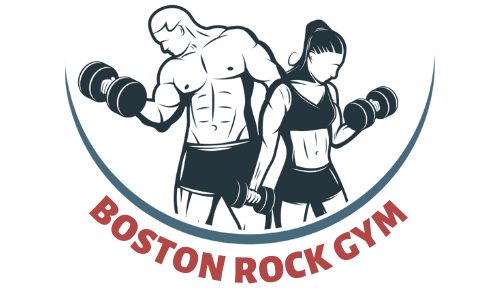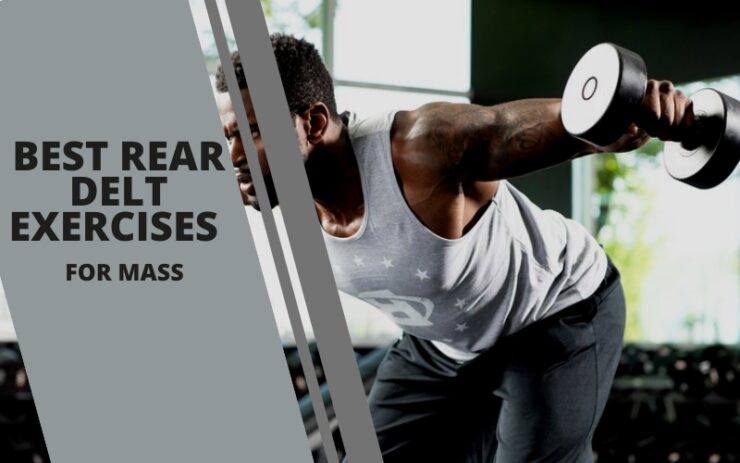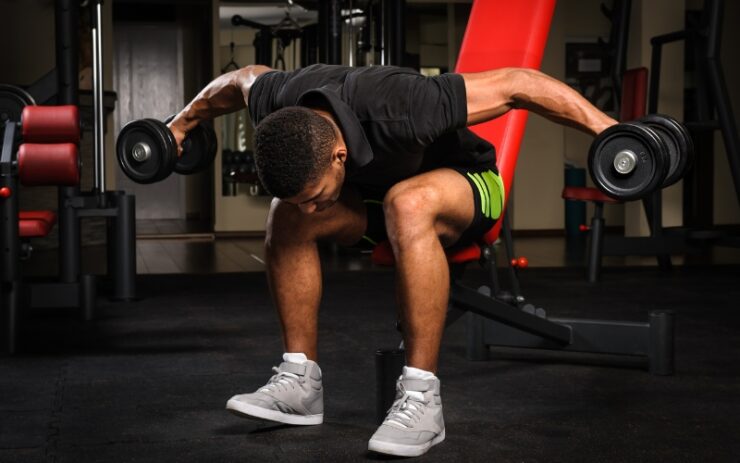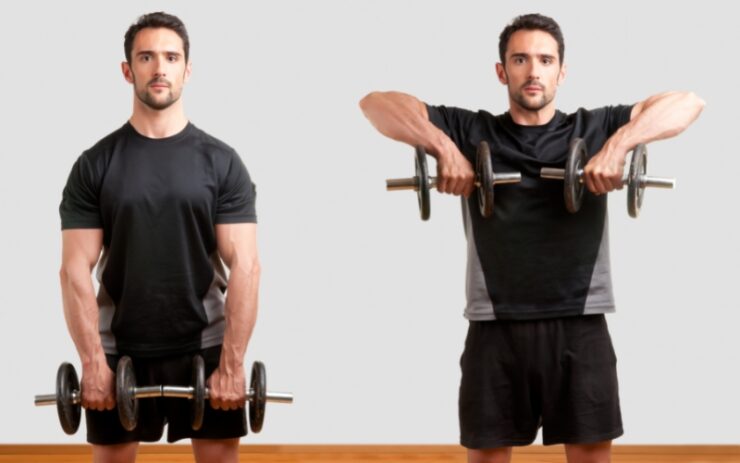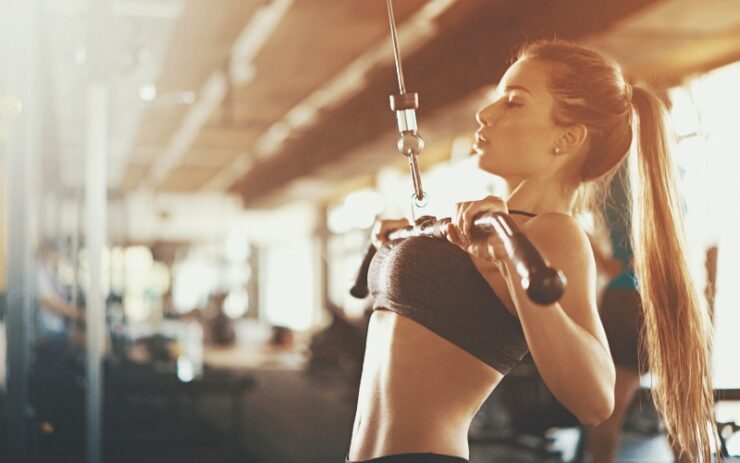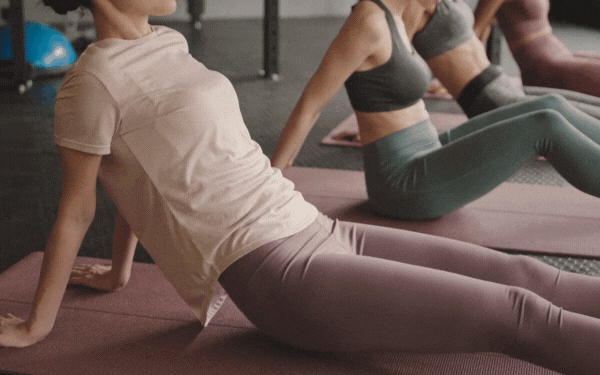If you’re in search of the best rear delt exercises for mass, we got you covered! We’re here to provide you with a list of the top 8 best rear delt exercises for mass that you can use both at home and in the gym! You won’t have to struggle and waste time trying to find appropriate exercises.
All you need to do is go through our list and pick your favorite ones! It will only take a few minutes and you’ll be ready to start exercising right away.
Contents
Top 8 Best Rear Delt Exercises for Mass
1. Bent Over Dumbbell Reverse Fly
You may execute the belt over dumbbell reverse flye while standing or while hunched over on an inclined bench with assistance (self-supported). To guarantee that gravity is still forcing the weights downward at an angle, your body should be almost parallel to the floor or slightly slanted upward from that.
The chest-supported reverse fly is a fantastic alternative because it limits the amount of body swing and momentum that can be employed and prevents the lifter from changing the angle to make the action easier as they get more fatigued. Here’s how to perform this exercise:
- Go into the open after choosing the desired weight from the rack
- When your body is virtually parallel to the floor, hinge from your hips and let your arms hang freely from your shoulders with a neutral grip
- Breathe deeply and raise the weights to the ceiling utilizing your rear deltoids
- Dumbbells should be brought back to the beginning position slowly and under control
- Repeat as many times as necessary
2. Tabletop Reverse Pike
The tabletop reverse pike increases your total strength and stability while focusing on and strengthening your core, shoulders, and arms. This bodyweight rear delt workout also works your shoulders, glutes, and legs, giving you a great all-around workout. Follow the next steps to perform this exercise:
- Stretch your legs out in front of you as you sit down on the ground. Spread your fingers wide and place your palms on the floor just outside and behind your hips
- When the knees are 90 degrees and the torso is parallel to the floor, press your palms into the ground and lift your hips off the ground
- Straight arms with hands squarely under the shoulders and ankles directly under the knees are preferred
- Balance on your hands and heels while contracting your abs
- For a predetermined period of time, maintain this stance
3. Dumbbell Upright Row
The dumbbell upright row is a standing exercise that helps strengthen the traps and rear delts. When performed with control and moderate to low weights, this exercise is quite helpful.
Consider this exercise to be the standing equivalent of a face pull, where you bring your elbows straight up and keep them out while you raise the weights above your face. You should go lighter if you are unable to lift your chin’s weight. Here are the steps:
- As you begin, stand with a dumbbell in each hand
- Put the dumbbells in your front body position with your palms towards you and your hands apart
- Lean forward with your back flat or arched and your chest up to allow the dumbbells to protrude an inch or two from your torso
- Lift the elbows up while maintaining them outspread
- Make sure the elbows are always elevated so they are above the wrists
- Lift the weights until you can no longer do so without experiencing any pain
- Pause at the top and make sure your elbows are up and pointing outward
- Lower the weights gradually to the starting position
4. Crab Walk
The crab walk is a great all-around workout that concentrates on strengthening the core, upper arms, shoulders, and upper legs. When you don’t have a lot of time or workout equipment on hand, routines like the crab walk are excellent total-body exercises that don’t require any additional equipment. Follow these steps to do the crab walk exercise successfully:
- Position yourself face up with your hands and feet flat on the ground
- Your gluteal muscles should be tensed in order to raise your butt off the ground
- Start “walking” by putting your hands and feet in motion first
- Move your hands around 6 to 8 inches (15 to 20 cm) at a time to reduce unnecessary shoulder strain
5. Cable Face Pull
A rope is frequently used when performing the cable face pull, a rear delt exercise, in order to allow the hands to be pushed apart as they come closer to the body. The height of the pulley can be adjusted for this exercise in accordance with personal preference. The handle should at least start at chest height (and be pulled upward at an angle) before moving up to somewhat over the head. Any higher and it will turn into a pulldown, while too low and it will turn into an upright row. Here’s what you should do:
- In front of a cable system, position yourself so that the pulley is at breast level
- Connect a rope attachment to the cable clip and grasp the rope’s ends in opposite directions
- As you grasp the end of the ropes, your palms and thumbs should be facing downward
- Pull the elbows back toward your ears and the hands apart (you should be pushing the rope ends apart to allow the center of the rope to travel toward your face)
- Keep your elbows up and in front of your ears
- Return the weight to the stack by slowly extending your hands out in front of you
6. High Reverse Plank
An exercise that is excellent for the core is the reverse plank exercise. The erector spinae, gluteus maximus, and hamstrings—three major muscles of the posterior chain—as well as your core, can all benefit greatly from this bodyweight shoulder exercise. Beginners should begin by mastering the standard plank. As you improve your form, try holding the reverse plank for only a few seconds at a time. Follow the next steps to complete this exercise:
- Stretch your legs out in front of you as you sit down on the ground. Spread your fingers wide and place your palms on the floor just outside and behind your hips
- Once your body is straight, lift your hips off the ground. Maintain a straight posture while looking up at the ceiling
- From head to heels, maintain a firm alignment across your entire body
- Try to bring your belly button back toward your spine while squeezing your back delts and core
- For a predetermined period of time, maintain this stance
7. Incline Bench Rear Lateral Raise
The incline bench rear lateral raise works the upper body’s posterior or rear deltoids as well as the upper back’s postural muscles. Due to the fact that this exercise targets such little muscles, it is often done with minimal weights for high repetitions—typically 10-15 reps per set or more. Other advantages of this exercise include the development of the posterior deltoids’ growth and strength. With this rear delt workout, shoulders get larger, more stable, and healthier.
- Holding dumbbells with neutral grips, sit backward on an inclined bench (45 degrees)
- Dumbbells should hang straight down from your shoulders while you hold them
- Pull through the middle traps and rear delts as you slowly raise the dumbbells up and out to the sides of your body
- At the peak of the action, pause briefly before gradually lowering the weights back to the starting position
8. Side-Lying Rear Delt Fly
An exercise for the shoulders that targets the rear delts is the side-lying rear delt fly. It is a fantastic unilateral exercise for a muscle area that is smaller and frequently sluggish. You can lie on a seat in place of the ground. The side-lying dumbbell rear delt raise is another name for the side-lying reverse dumbbell fly. This is how you perform a side-lying rear dealt fly:
- Lie on your right side on the floor, and use a neutral grip to hold the dumbbell in your left hand (palm facing downward)
- Breathe out as you lift the dumbbell from the floor until it is virtually vertical, keeping your elbow steady and your body motionless. Hold for two counts
- Breathe deeply as you turn the motion around and descend the dumbbell back to the beginning position, halting just before it reaches the ground
- The appropriate number of times should be repeated. Your right arm should be used to do the exercise on the opposite side
Conclusion
If you want to get the most out of these rear delt exercises for mass, make sure you mix and match them. You can create a workout regimen that includes all (or most) of them, and do different ones on different days.
Also, remember to incorporate rest days into your workout regimen as well, so that you don’t overwork or injure yourself. Other than that, maintain a healthy, protein-rich diet, and you’ll reach your goals in no time!
